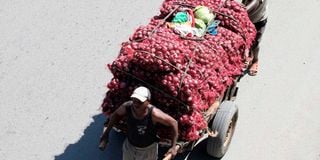Onion waste management

Onions being delivered to traders at Kongowea market in Mombasa. Waste during production includes residue after harvesting, weeds removed and bottles.
A lot of waste is generated from the different activities carried out on the farm during crop production.
This waste requires proper management to reduce its impacts on the environment. The waste could be biodegradable or non-biodegradable.
Desmond’s farm is not an exception. In this article, we look at waste management in onion production.
The waste includes residue after harvesting, weeds removed and chemical bottles.
It is important to ensure the waste is separated into biodegradable and non-biodegradable categories after being gathered on the farm.
Biodegradable waste is decomposed and used as manure to increase yields. It includes weeds and agriculture by-products.
Non-biodegradable waste should be recycled or dumped at the specified disposal sites.
Degradable waste
Degradable waste can be broken down through decomposition. Decomposition is the process through which organic materials are broken down into simpler forms primarily by bacteria and fungi.
As a result, the materials are transformed into forms that can be employed as crop nutrients in the soil. Additionally, it helps improve soil structure.
The heat generated during decomposition kills unwanted organisms such as pests and weed seeds, hence the need to ensure the waste is fully decomposed.
A farmer can choose to have a location that is well-built or dig a hole.
Though digging a pit results in the loss of nutrients, owing to leaching, permanent structures are recommended.
Desmond built two compost pits each 4x4 metres and a metre deep.
He filled the pit with biodegradable waste, then covered it with a thin layer of soil. He added water in small quantities to speed up the breakdown. Desmond can disintegrate the waste at various intervals during production.
After four weeks, the decaying materials should be moved to the next pit and mixed well until it is dissolved entirely.
The procedure should take three to four months.
The vermicomposting system is available to farmers. It is a quick and exciting method of creating rich compost from farm waste.
Organic waste
Red worms are used to convert organic waste into compost. If a significant volume of manure needs to be produced, it can be done in a large container or drum.
For the non-degradable waste, Desmond separated reusable from non-reusable and transferred the reusable to the waste collection points.
Seed packets and other trash should be burnt. Bottles should be washed to remove any remaining chemicals before being emptied into the soak pit. The bottles are then perforated to prevent them from being used for other purposes.
There are companies that collect the bottles for disposal. Burning the chemicals is not recommended because some are toxic or explosive.
Irrigation should depend on the crop’s water requirements to reduce waste.
Drip lines that are beyond repair should be collected and disposed of appropriately.
After the onions are harvested, crop waste can be managed by decomposing.
The land is then ploughed in preparation for the next growing season





